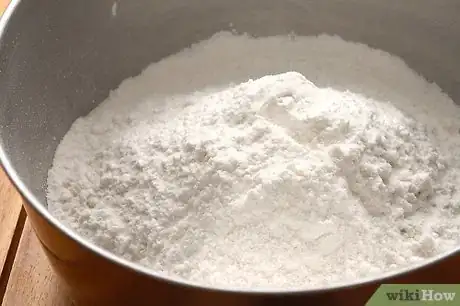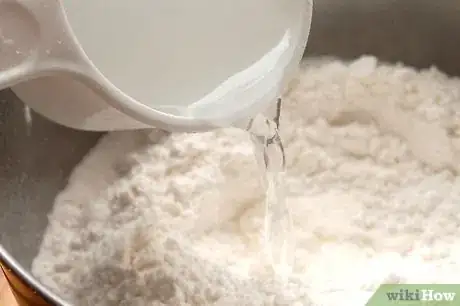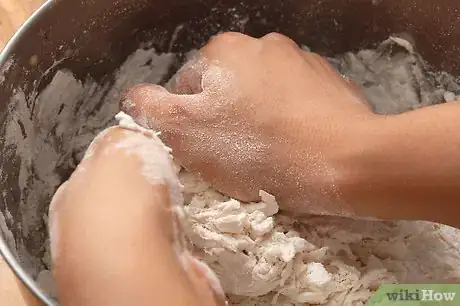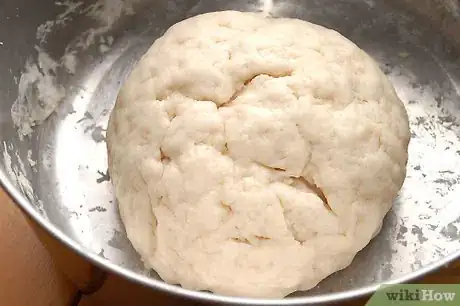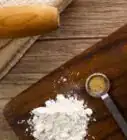wikiHow is a “wiki,” similar to Wikipedia, which means that many of our articles are co-written by multiple authors. To create this article, volunteer authors worked to edit and improve it over time.
This article has been viewed 52,869 times.
Learn more...
Gluten is a protein found in cereal grains and is the major functional component in wheat flour. Also known as vital wheat gluten, it is responsible for the final texture of bread products. Different wheat flours have different protein content; pastry flour has less protein and yields a softer final product whereas bread flour has more protein and yields a firmer final product. All-purpose flour, which has an average protein content that works well for making many dough products, is also extracted from wheat for use in other food products. Vital wheat gluten is often added to meat substitute products as well to help give them strength and texture.
Wheat gluten consists of two major proteins, glutenin and gliadin, that are responsible for the elastic and cohesive properties of gluten. It is these properties that allow for dough to retain gas and expand (or rise), which is what causes the empty pockets of air in bread. It is also gluten that allows for a dough to be sheeted into a thinner dough or pasta without tearing or crumbling. From a nutritional standpoint, gluten provides calories, protein, carbohydrates and some fat. When making bread, it is important to understand how to properly develop gluten in order to prevent it from tearing or sticking during the preparation process.
Steps
-
1Blend all the dry ingredients together well for your dough. Blending the ingredients well before adding water will ensure that the ingredients do not become entrapped in isolated clumps once the water has been added.
-
2Add the water to the dough while mixing slowly. Incorporating water dissolves the ingredients and begins hydrating the gluten on the surface of the flour.
- Adding the water slowly allows more time for hydrating the gluten and more time for the gluten particles to interact with one another. After the water is added, the dough should start to become sticky and cohesive. This is a sign that the gluten is hydrating but it hasn’t started developing yet at this stage.
- If the dough still looks dry after the water has been added according to your recipe, gradually add a little more water at a time to fully hydrate the gluten.
- You’ve added too much water if the dough looks “soupy.”
Advertisement -
3Mix the dough more vigorously. The energy created in mixing is required for the gluten particles to interact and create a matrix that allows for the entrapment and expansion of air.
- At the start of this process, the dough should be sticking together and forming a cohesive mass. Your goal at this stage is to turn the sticky ball without any elastic properties into a drier ball that is very elastic and holds it shape well.
- If the dough becomes over-mixed, it will lose the elasticity and look as if it were over-hydrated.
-
4Check the dough for proper gluten development. Once the watering and mixing stages are complete, the dough needs to be checked for proper gluten development. If the gluten is not developed completely at this point, the dough can still be saved by adding more water or mixing longer, or by a combination of both.
- The dough should be a cohesive mass that is smooth throughout. If the dough is mixed properly and the gluten is completely developed, it will be slightly sticky or not sticky at all when handled and will stay as one piece when moved.
- A small piece of dough should stretch without tearing when stretched gently in your hands. You should be able to stretch it until it forms a thin translucent film without any having any thick spots or tears.
Community Q&A
-
QuestionHow do you get the bread hollow to fry it?
 Community AnswerKnead the dough for longer than 15 minutes, then let it set for 15 to 30 minutes.
Community AnswerKnead the dough for longer than 15 minutes, then let it set for 15 to 30 minutes. -
QuestionWhat's the difference in mixing quick breads with the muffin method as opposed to the biscuit method?
 Community AnswerBasically, your wet ingredients are going to react with gluten and yeast to rise the dough, and most people prefer to use wet then dry method as their hands don't get messy. However, it's really up to you.
Community AnswerBasically, your wet ingredients are going to react with gluten and yeast to rise the dough, and most people prefer to use wet then dry method as their hands don't get messy. However, it's really up to you. -
QuestionWhat is the gluten development in quick breads?
 Community AnswerTypically, the primary action that develops gluten in quick breads is agitation, i.e. mixing. In quick breads, though, one does not want to develop gluten, since the finished product is intended to be like a firm cake rather than bread; tender is better. Resting a batter partially counteracts gluten development. Here's my method: once all ingredients are added, stir until there is just a scant trace of some dry stuff still visible, then mix on a medium-slow speed for exactly two minutes. Scrape the bowl down, and pour batter into prepared pans. Tamp the pans to remove air bubbles. Allow to rest 5 minutes. Tamp pans again to remove lingering bubbles, then bake.
Community AnswerTypically, the primary action that develops gluten in quick breads is agitation, i.e. mixing. In quick breads, though, one does not want to develop gluten, since the finished product is intended to be like a firm cake rather than bread; tender is better. Resting a batter partially counteracts gluten development. Here's my method: once all ingredients are added, stir until there is just a scant trace of some dry stuff still visible, then mix on a medium-slow speed for exactly two minutes. Scrape the bowl down, and pour batter into prepared pans. Tamp the pans to remove air bubbles. Allow to rest 5 minutes. Tamp pans again to remove lingering bubbles, then bake.
Warnings
- There is no extra benefit to a gluten free diet unless a person has Celiac disease or has identified a lower-level intolerance or sensitivity to gluten.⧼thumbs_response⧽
- Celiac disease is a bowel disease that damages the lining of the intestine, which is sparked by the body’s adverse reaction to gluten. People with Celiac disease should avoid eating foods with added vital wheat gluten or that are made with wheat, and should consult a nutritionist about relevant dietary restrictions.⧼thumbs_response⧽
References
- http://www.usatoday.com/news/health/painter/2008-08-17-gluten_N.htm
- Kulp, K. (2000). Handbook of Cereal Science and Technology. CRC Press. Retrieved from EBSCOhost.
- American Institute of Baking (2007). Science of Baking: Breads and Rolls. AIB baking science textbook.
